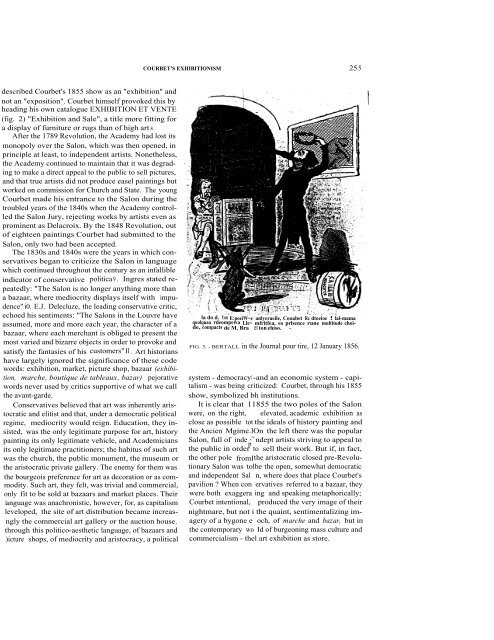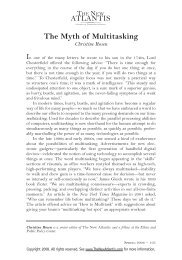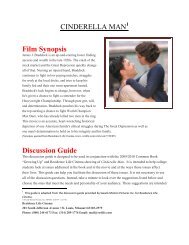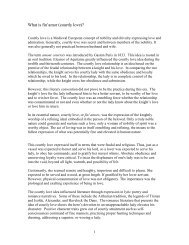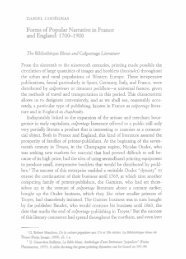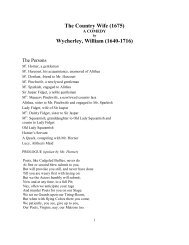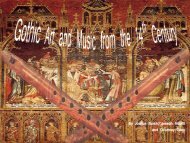Courbet's Exhibitionism
Courbet's Exhibitionism
Courbet's Exhibitionism
Create successful ePaper yourself
Turn your PDF publications into a flip-book with our unique Google optimized e-Paper software.
described <strong>Courbet's</strong> 1855 show as an "exhibition" and<br />
not an "exposition". Courbet himself provoked this by<br />
heading his own catalogue EXHIBITION ET VENTE<br />
(fig. 2) "Exhibition and Sale", a title more fitting for<br />
a display of furniture or rugs than of high art s .<br />
After the 1789 Revolution, the Academy had lost its<br />
monopoly over the Salon, which was then opened, in<br />
principle at least, to independent artists. Nonetheless,<br />
the Academy continued to maintain that it was degrading<br />
to make a direct appeal to the public to sell pictures,<br />
and that true artists did not produce easel paintings but<br />
worked on commission for Church and State. The young<br />
Courbet made his entrance to the Salon during the<br />
troubled years of the 1840s when the Academy controlled<br />
the Salon Jury, rejecting works by artists even as<br />
prominent as Delacroix. By the 1848 Revolution, out<br />
of eighteen paintings Courbet had submitted to the<br />
Salon, only two had been accepted.<br />
The 1830s and 1840s were the years in which conservatives<br />
began to criticize the Salon in language<br />
which continued throughout the century as an infallible<br />
indicator of conservative politica 9 . Ingres stated repeatedly:<br />
"The Salon is no longer anything more than<br />
a bazaar, where mediocrity displays itself with impudence"<br />
i0. E.J. Delecluze, the leading conservative critic,<br />
echoed his sentiments: "The Salons in the Louvre have<br />
assumed, more and more each year, the character of a<br />
bazaar, where each merchant is obliged to present the<br />
most varied and bizarre objects in order to provoke and<br />
satisfy the fantasies of his customers" Il . Art historians<br />
have largely ignored the significance of these code<br />
words: exhibition, market, picture shop, bazaar (exhibition,<br />
marche, boutique de tableaux, bazar) pejorative<br />
words never used by critics supportive of what we call<br />
the avant-garde.<br />
Conservatives believed that art was inherently aristocratic<br />
and elitist and that, under a democratic political<br />
regime, mediocrity would reign. Education, they insisted,<br />
was the only legitimate purpose for art, history<br />
painting its only legitimate vehicle, and Academicians<br />
its only legitimate practitioners; the habitus of such art<br />
was the church, the public monument, the museum or<br />
the aristocratic private gallery. The enemy for them was<br />
the bourgeois preference for art as decoration or as commodity.<br />
Such art, they felt, was trivial and commercial,<br />
only fit to be sold at bazaars and market places. Their<br />
language was anachronistic, however, for, as capitalism<br />
leveloped, the site of art distribution became increasngly<br />
the commercial art gallery or the auction house.<br />
through this politico-aesthetic language, of bazaars and<br />
)icture shops, of mediocrity and aristocracy, a political<br />
COURBET'S EXHIBITIONISM 25 5<br />
la do d. Yon E:poeiW~e anlyeraeile, Cooabet Re dtoeioe ! lal-mama<br />
quolquaa rdeompewa Lle~ mfritfea, on prlsence rune multitude choide,<br />
compacts de M. Bra et ton ehiso. -<br />
FIG. 3. - BERTALL in the Journal pour tire, 12 January 1856.<br />
system - democracy I-and an economic system - capitalism<br />
- was being criticized: Courbet, through his 1855<br />
show, symbolized bh institutions.<br />
It is clear that 11855 the two poles of the Salon<br />
were, on the right, elevated, academic exhibition as<br />
close as possible tot the ideals of history painting and<br />
the Ancien Mgime.lOn the left there was the popular<br />
Salon, full of inde p ,~ ndept artists striving to appeal to<br />
the public in order to sell their work. But if, in fact,<br />
the other pole fromIthe aristocratic closed pre-Revolutionary<br />
Salon was tolbe the open, somewhat democratic<br />
and independent Sal n, where does that place <strong>Courbet's</strong><br />
pavilion ? When con ervatives referred to a bazaar, they<br />
were both exaggera ing and speaking metaphorically;<br />
Courbet intentional, produced the very image of their<br />
nightmare, but not i the quaint, sentimentalizing imagery<br />
of a bygone e och, of marche and bazar, but in<br />
the contemporary wo Id of burgeoning mass culture and<br />
commercialism - thel art exhibition as store.


